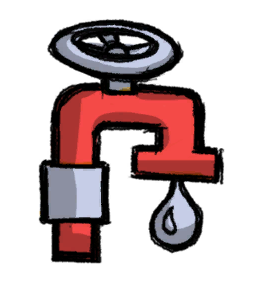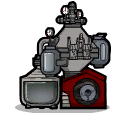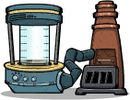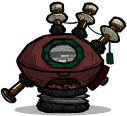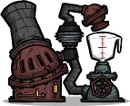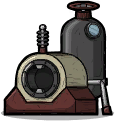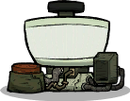Ethanol Distiller
Ethanol Distiller converts Wood into Ethanol, Polluted Dirt, and Carbon Dioxide.
The Ethanol Distiller needs to be supplied with Wood to operate. It will output the Ethanol from its output pipe while continuously emitting Carbon Dioxide to the surrounding environment, and dropping Polluted Dirt on the floor.
All outputs have minimum temperatures, and will be higher in temperature if the input wood's temperature is above those minimums (e.g. 80C wood will produce 80C ethanol, and polluted dirt and CO2 at the minimum of 93.4C).
Usage
The Ethanol Distiller requires an input of 1 kg/s of Wood, which can be automated using Auto-Sweepers. While active, it will drop Polluted Dirt in lumps of 20 kg from the hatch down its furnace part. Produced Ethanol can be piped into a Petroleum Generator to produce Power.
Heat Economy
Ethanol Distillers can be run as net heat negative if the wood is at least 38.6 °C (independently), if they feed into Petroleum Generator that number drops down to 34 °C. It is not potent enough to fully negate an Arbor Tree's mass multiplying effects, but something might be gained by keeping trees in a colder environment and preheating Wood.
Tips
- Ethanol Distillers do not overheat.
- 1.8 domestically growing Arbor Trees provide enough Wood to keep an Ethanol Distiller running.
- One Ethanol Distiller can feed 5 Slicksters or irrigate 15 Nosh Sprouts.
- 4 Ethanol Distillers are required to support one constantly running Petroleum Generator.
- This produces a net power gain of +260 W per distiller (1040 W total), or +510 W (2040 W) if the Petroleum Generator is boosted.
- Alternatively, if all Carbon Dioxide from the distiller and the generator are converted to Petroleum using Molten Slicksters, 3 distillers are needed per generator (the other 500 g/s is provided by the slicksters). This will require 30 Molten Slicksters.
- One constantly running Ethanol Distiller provides almost 200 kg/cycle Polluted Dirt, enough to keep 3.33 Composts occupied if they are instantly flipped.
- Which produce enough Dirt to fertilize ~20 domesticated Arbor Trees.
- Alternatively, it can be used to feed ~3 Pokeshells or ~1.4 Sage Hatches.
- There are no clean golden ratios of production here short of extremely large setups.
- Example, 108 trees to 60 distillers to 20 generators, 15 of which are running on Ethanol and the remaining 5 of which are running on Petroleum from Molten Slicksters. This setup would produce:
- Up to 60 kW of power (with Engie's Tune-Up)
- 1.44 t/cycle of excess Polluted Water beyond what the trees consume, and 9 t/cycle total that needs to be pumped (1.5 pipelines and pumps)
- 12 t/cycle Polluted Dirt, of which 1.08 t/cycle needs to be composted into dirt to feed the trees (at least 18 compost heaps). A minimum of 200 compost heaps would be needed if all of it were to be converted into Dirt.
- 12 t/cycle of Carbon Dioxide that would need to be routed to the slicksters (10 full ventilation pipes, fed by 20 pumps). This would require a total of 600 Molten Slicksters, assuming all of them are always groomed and happy, or 3000 if they are left in a glum state.
- Needless to say, this is not recommended.
- "Good enough" ratios:
- 8 trees to 4 distillers to 1 generator, if not using slicksters
- 6 trees to 3 distillers to 2 generators (1 Ethanol, running 75% of the time, 1 Petroleum running 25% of the time) if using slicksters (30 happy slicksters or 120 glum slicksters required).
- Example, 108 trees to 60 distillers to 20 generators, 15 of which are running on Ethanol and the remaining 5 of which are running on Petroleum from Molten Slicksters. This setup would produce:





